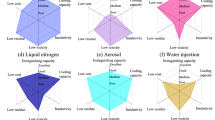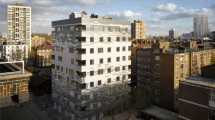Abstract
This study describes an experimental investigation on the fire performance of intumescent coatings using two different bench-scale experimental methodologies. Steel plates with and without a commercially available thin-intumescent coating were tested using a 26 dm3 propane-fired furnace or an array of natural-gas-fired radiant panels in accordance with the Heat-Transfer Rate Inducing System (H-TRIS) test method. Research outcomes demonstrate how the two bench-scale experimental methodologies can be adopted to effectively research and develop intumescent coatings for a range of equivalent thermal exposures. A comprehensive comparative analysis between the two methods was performed based on the transient swelling behaviour of the intumescent coating and the temperature of the steel substrate. The H-TRIS test method imposes well-defined and stable thermal conditions at the exposed surface of the swelling intumescent coating, while the mixed convective-radiative thermal conditions inside the bench-scale furnace occur over the whole coating surface, and their distribution and homogeneity are difficult to quantify in practice. Also, at high temperatures, the turbulent flow fields inside the furnace affected the coating degradation, showing detachment (partial or total, gradual, or sudden) of the swelled char and generating increased uncertainty of the thermal and physical conditions, but reproducing scenarios more realistic and similar to real compartment fires. Lastly, the H-TRIS test method allows for the measurement of the transient coating swelling during heating, but also exposed the tested samples to higher oxygen concentrations than those tested inside the furnace.
Graphical Abstract
















Similar content being viewed by others

References
Buchanan AH, Abu AK (2017) Structural design for fire safety. John Wiley & Sons, 2nd Edition https://doi.org/10.1002/9781118700402
Weil ED (2011) Fire-protective and flame-retardant coatings – A state-of-the-art review. Journal of Fire Science 29:259–296. https://doi.org/10.1177/0734904110395469
Puri EG, Khanna AS (2017) Intumescent coatings: a review on recent progress. J Coat Technol Res 14:1–20. https://doi.org/10.1007/s11998-016-9815-3
Mariappan T (2016) Recent developments of intumescent fire protection coatings for structural steel: A review. J Fire Sci 34(2):1–44. https://doi.org/10.1177/0734904115626720
Elliott A., Temple A., Maluk C. and Bisby L. (2014) Novel testing to study the performance of intumescent coatings under non-standard heating regimes. Fire Safety Science – Proceedings of the 11th International Symposium, University of Canterbury New Zealand, pp. 652–665, https://doi.org/10.3801/IAFSS.FSS.11-652
Comité Européen de Normalisation (CEN) (2013) EN 13381–8, Test methods for determining the contribution to the fire resistance of structural members - Part 8: Applied reactive protection to steel members. Brussel, Belgium
Comité Européen de Normalisation (CEN) (2002) EN 1991–1–2, Eurocode 1: Actions on structures - Part 1–2: General actions – Actions on structures exposed to fire. Brussel, Belgium
International Organization for Standardization (ISO) (1999) ISO834–1, Fire resistance Tests - Elements of Building Construction - Part 1: General Requirements for Fire Resistance Testing. Switzerland, Geneva
American Society for Testing and Materials (ASTM) (2012) ASTM E119:2012 Standard Test Methods for Fire Tests of Building Construction and Materials. West Conshohocken, Pennsylvania
Underwriters Laboratories Inc. (2017) UL 1709: Rapid rise fire tests of protection materials for structural steel. Northbrook, United States of America
Lucherini A, Maluk C (2019) Intumescent coatings used for the fire-safe design of steel structures: A review. J Construct Steel Res 162:105712. https://doi.org/10.1016/j.jcsr.2019.105712
Dreyer JAH, Weinell CE, Dam-Johansen C, Kill S (2021) Review of heat exposure equipment and in-situ characterisation techniques for intumescent coatings. Fire Saf J 121:103264. https://doi.org/10.1016/j.firesaf.2020.103264
Gardelle B, Duquesne S, Vandereecken P, Bellayer S, Bourbigot S (2013) Resistance to fire of intumescent silicone-based coating: The role of organoclay. Prog Org Coat 76:1633–1641. https://doi.org/10.1016/j.porgcoat.2013.07.011
Nørgaard KP, Dam-Johansen K, Catala P, Kiil S (2014) Laboratory and gas-fired furnace performance tests of epoxy primers for intumescent coatings. Prog Org Coat 77(10):1577–1584. https://doi.org/10.1016/j.porgcoat.2013.10.018
Lucherini A, Giuliani L, Jomaas G (2018) Experimental study of the performance of intumescent coatings exposed to standard and non-standard fire conditions. Fire Saf J 95:42–50. https://doi.org/10.1016/j.firesaf.2017.10.004
Morys M, Illerhaus B, Sturm H, Schartel B (2017) Revealing the inner secrets of intumescence: Advanced standard time temperature oven (STT Mufu+) - μ-computed tomography approach. Fire Mater 41(8):927–939. https://doi.org/10.1002/fam.2426
Morys M, Häßler D, Krüger S, Schartel B, Hothan S (2020) Beyond the standard time-temperature curve: Assessment of intumescent coatings under standard and deviant temperature curves. Fire Saf J 112:102951. https://doi.org/10.1016/j.firesaf.2020.102951
Bartholmai M, Schriever R, Schartel B (2003) Influence of external heat flux and coating thickness on the thermal insulation properties of two different intumescent coatings using cone calorimeter and numerical analysis. Fire Mater 27(4):151–162. https://doi.org/10.1002/fam.823
Zhang Y, Wang Y, Bailey CG, Taylor AP (2012) Global modelling of fire protection performance of an intumescent coating under different cone calorimeter heating conditions. Fire Saf J 50:51–62. https://doi.org/10.1016/j.firesaf.2012.02.004
Lucherini A, Maluk C (2019) Assessing the onset of swelling for thin intumescent coatings under a range of heating conditions. Fire Saf J 106:1–12. https://doi.org/10.1016/j.firesaf.2019.03.014
Bourbigot S, Le Bras M, Duquesne S, Rochery M (2004) Recent Advances for Intumescent Polymers. Macromol Mater Eng 289:499–511. https://doi.org/10.1002/mame.200400007
Bourbigot S, Duquesne S (2007) Fire retardant polymers: recent developments and opportunities. J Mater Chem 17:2283–2300. https://doi.org/10.1039/B702511D
Zeng Y, Weinell CE, Dam-Johansen K, Ring L, Kiil S (2020) Comparison of an industrial- and a laboratory-scale furnace for analysis of hydrocarbon intumescent coating performance. J Fire Sci 38(3):309–329. https://doi.org/10.1177/0734904120902852
International Organization for Standardization (ISO) (2007) ISO 8501–1:2007 Preparation of steel substrates before application of paints and related products - Visual assessment of surface cleanliness - Part 1: Rust grades and preparation grades of uncoated steel substrates and of steel substrates after overall removal of previous coatings. Geneva, Switzerland
Lucherini A, Razzaque QS, Maluk C (2019) Exploring the fire behaviour of thin intumescent coatings used on timber. Fire Saf J 109:102887. https://doi.org/10.1016/j.firesaf.2019.102887
Lucherini A, Hidalgo JP, Torero JL, Maluk C (2020) Influence of heating conditions and initial thickness on the effectiveness of thin intumescent coatings. Fire Saf J. https://doi.org/10.1016/j.firesaf.2020.103078
Lucherini A, Torero JL, Maluk C (2019) “Effects of substrate thermal conditions on the swelling of thin intumescent coatings” Interflam 2019: Fire Resistance. Fire Mater. https://doi.org/10.1002/fam.2840
Lucherini A (2020) Fundamentals of thin intumescent coatings for the design of fire-safe structures. PhD thesis, School of Civil Engineering, The University of Queensland, https://doi.org/10.14264/uql.2020.1021
Gardelle B, Duquesne S, Vandereecken P, Bourbigot S (2013) Characterization of the carbonization process of expandable graphite/silicone formulations in a simulated fire. Polym Degrad Stab 98:1052–1063. https://doi.org/10.1016/j.polymdegradstab.2013.02.001
Jimenez M, Bellayer S, Revel B, Duquesne S, Bourbigot S (2013) Comprehensive study of the influence of different aging scenarios on the fire protective behavior of an epoxy based intumescent coating. Ind Eng Chem Res 52:729–743. https://doi.org/10.1021/ie302137g
Jimenez M, Bellayer S, Naik A, Bachelet P, Duquesne S, Bourbigot S (2016) Topcoats versus durability of an intumescent coating. Ind Eng Chem Res 55:9625–9632. https://doi.org/10.1021/acs.iecr.6b02484
Naik AD, Duquesne S, Bourbigot S (2016) Hydrocarbon time-temperature curve under airjet perturbation: An in situ method to probe char stability and integrity in reactive fire protection coatings. J Fire Sci 34:385–397. https://doi.org/10.1177/0734904116658049
Okyay G, Naik AD, Samyn F, Jimenez M, Bourbigot S (1872) Fractal conceptualization of intumescent fire barriers, toward simulations of virtual morphologies. Sci Rep 9:2019. https://doi.org/10.1038/s41598-019-38515-9
Okyay G, Samyn F, Jimenez M, Bourbigot S, Okyay G, Samyn F, Jimenez M, Bourbigot S (2019) A facile technique to extract the cross-sectional structure of brittle porous chars from intumescent coatings. Polymers 11:640. https://doi.org/10.3390/polym11040640
Gardelle B, Duquesne S, Vandereecken P, Bourbigot S (2014) Resistance to fire of silicone-based coatings: Fire protection of steel against cellulosic fire. J Fire Sci 32(4):374–387. https://doi.org/10.1177/0734904114522390
Maluk C, Bisby L, Krajcovic M, Torero JL (2019) A heat-transfer inducting system (H-TRIS) test method. Fire Saf J 105:307–319. https://doi.org/10.1016/j.firesaf.2016.05.001
Lucherini A. and Maluk C. (2017) Novel test methods for studying the fire performance of thin intumescent coatings. Proceedings of 2nd International Fire Safety Symposium (IFireSS), Napoli, Italy 565–572
Incropera F.P., DeWitt D.P., Bergman T.L. and Lavine A.S. (2006) Fundamental of heat and mass transfer. John Wiley & Sons, 6th Edition
Comité Européen de Normalisation (CEN) (2005) EN 1993–1–2, Eurocode 3: Design of steel structures - Part 1–2: General rules - Structural fire design. Belgium, Brussels
Horacek H (2009) Reactions of stoichiometric intumescent paints. J Appl Polym Sci 113:1745–1756. https://doi.org/10.1002/app.29940
Wang Z, Han E, Ke W (2006) Effects of nanoparticles on the improvement in fire-resistant and anti-ageing properties of flame-retardant coating. Surf Coat Technol 200:5706–5716. https://doi.org/10.1016/j.surfcoat.2005.08.102
Weisheim W, Schaumann P, Sander L, Zehfuss J (2019) Numerical model for the fire protection performance and the design of intumescent coatings on structural steel exposed to natural fires. J Struct Fire Engin. https://doi.org/10.1108/JSFE-01-2019-0004
de Silva D, Bilotta A, Nigro E (2019) Experimental investigation on steel elements protected with intumescent coating. Constr Build Mater 205:232–244. https://doi.org/10.1016/j.conbuildmat.2019.01.223
Wang L, Dong Y, Zhang D, Zhang D, Zhang C (2015) Experimental study of heat transfer in intumescent coatings exposed to non-standard furnace curves. Fire Technol 51(1):627–643. https://doi.org/10.1007/s10694-015-0460-7
Muller M, Bourbigot S, Duquesne S, Klein RA, Giannini G, Lindsay CI (2013) Measurement and investigation of intumescent char strength: Application to polyurethanes. J Fire Sci 31(4):293–308. https://doi.org/10.1177/0734904112472015
Acknowledgements
The authors would like to gratefully acknowledge the scientific and technical support kindly offered by the Fire Safety Engineering Research Group at the University of Queensland (in particular Jeronimo Carrascal Tirado and Stewart Matthews) and the University of Lille (in particular Pierre Bachelet). The authors would also like to thank Remedial Building Services Australia Pty Ltd, especially Qazi Samia Razzaque, Edward Kwok, Long Le and Andrew Abrahams.
Author information
Authors and Affiliations
Contributions
AL Conceptualization, Methodology, Validation, Investigation, Resources, Writing—Original Draft; HYL Investigation, Resources; MJ Resources, Writing—Review & Editing; FS Resources, Writing—Review & Editing; SB Resources, Writing—Review & Editing; CM Conceptualization, Supervision, Writing—Review & Editing.
Corresponding author
Ethics declarations
Conflict of interest
The authors declare no conflicts of interest.
Additional information
Publisher's Note
Springer Nature remains neutral with regard to jurisdictional claims in published maps and institutional affiliations.
Rights and permissions
About this article
Cite this article
Lucherini, A., Lam, H.Y., Jimenez, M. et al. Fire Testing of Intumescent Coatings: Comparison Between Bench-Scale Furnace and Radiant Panels Experimental Methodologies. Fire Technol 58, 1737–1766 (2022). https://doi.org/10.1007/s10694-022-01216-3
Received:
Accepted:
Published:
Issue Date:
DOI: https://doi.org/10.1007/s10694-022-01216-3



